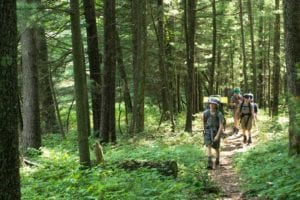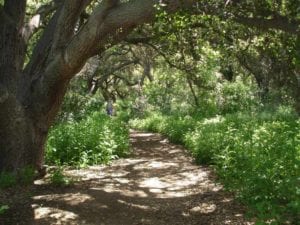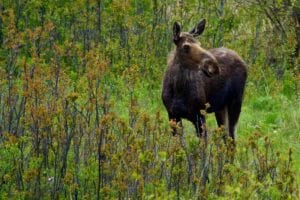By Leah Rambadt, American Forests
After you choose a trail and start planning your hike, remember that you’re not just entering nature — you’re entering the home of a variety of wildlifeand other living organisms. Whether you’re going on a day-trip or a week-long excursion, you should be considerate of nature and minimize your impact on it.
The “Leave No Trace Seven Principles” are the best guidelines to follow before, during and after an outdoor excursion. We won’t go through the principles in detail in this post, but will instead highlight how you should prepare for, behave during, and leave a day-trip hike to help nature maintain nature’s original state.
Preparing for a Hike

Factors to consider:
- The trail – Research the terrain and the surrounding environment. What is the hiking difficulty? Will you need extra equipment?
- The hikers – Are you hiking alone or in a group? When hiking in a group, keep each member’s skill level in mind. Can everyone maintain a constant pace, or will you need to allow for additional time to complete the hike?
- Weather – Check the forecast before you set out for your hike, and pack extra clothing, such as a raincoat, in case it takes a turn for the worst.
- First aid – Do you have a comprehensive and complete First Aid kit and training in case of an emergency?
These are some factors you need to consider when planning your hike, to ensure the experience is enjoyable for yourself and whoever you choose to hike with.
Also, use natural brands of sunscreen and bug sprays to avoid potentially harming the organisms around you.
During a Hike

Use trails whenever possible. They’re constructed to provide distinct routes that concentrate foot traffic, reducing the creation of multiple trails that could damage the landscape.
- Space: Give space to other groups taking breaks along the trail. Don’t crowd other groups – either let them pass, or wait.
- Right of Way: You should let faster groups pass by, and yield to those hiking uphill when you’re descending.
- Be a good group-member: Set an appropriate pace, warn others about loose rocks and other hazards, and hold overhanging branches out of the way so they don’t hit those behind you in the face. Stop at regular intervals, especially at spurs in the path, to regroup, and move on together.
Off-Trail Traveling
Two main factors affect the land while traveling off-trail: durability of surfaces and vegetation, and frequency of travel (or group size).
- Durability – The ability of surfaces or vegetation to withstand wear or remain in a stable condition. Some foliage can be extremely sensitive, and while walking may seem low impact, it can devastate a grouping of plants.
- Frequency of use/large group size – The more frequently off-trail traveling occurs, the more likely a large area will be trampled. In the case of a large group, a small area will be trampled multiple times.

Wildlife
The best way to interact with wildlife is to not interact with it at all. You shouldn’t pursue, touch, force animals to flee, or feed them; feeding wildlife causes them to become more vulnerable and dependent on people.
If you’re in a larger group, try to divide into smaller ones to minimize your impact. Travel quietly, and stop frequently to rest and talk. Don’t shout to communicate on the trail — unless there’s an emergency — to avoid disturbing the wildlife.
Leaving a Hike
The Big Takeaway

Evaluate your surroundings and leave them as you found them.
- If you clear an area of surface rocks, twigs, pine cones or other coverage, replace these items before leaving. Don’t drastically alter the area by creating improvements such as chairs or tables.
- If you carry items in, make sure to bring those items back out, especially trash.
- Take photos, not souvenirs. Picking flowers may not seem damaging, not like harming tree trunks or branches. However, if every visitor decided to pick “just a few flowers,” the flower population may become depleted to the point of not being able to recover. Eventually, the wildflowers would no longer be able to reproduce.
- Leave behind natural objects of beauty or interest (antlers, petrified wood, colorful rocks, etc.) to give others the opportunity to experience a sense of discovery. In national parks and some other public areas, it’s illegal to remove natural objects. This applies to cultural artifacts found on public land as well.
- Finally, reflect on your experience. What went well on your hike? What didn’t? Identifying these factors will help you improve your next hiking trip.
Keep these highlights in mind to make your hiking experience enjoyable and more considerate of nature. For more detailed information, check out the “Leave No Trace Seven Principles.” You’ll also find information on proper camping behavior.
Use these highlights and the “Leave No Trace” principles on your next outdoor excursion, and share your photos on social media by tagging @EddieBauer (and @AmericanForests), using #WhyIHike and #contest. You could win an epic hiking adventure!